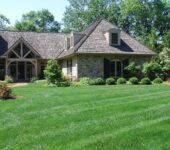Winter is finally over, which means it’s time to put away the snow shovels and start thinking about spring projects, such as your lawn.
Winter weather can leave your grass, shrubs and trees weak and hungry, especially after months of lying dormant under a blanket of ice and snow. If you want them to come back fuller and lusher than ever, follow these simple tips.
-
Do some cleaning.
The first step to prepping your lawn for spring is to clean up the leaves, twigs and other debris that have gathered over the winter. Rakes work, but air blowers are even easier. “Debris can get stuck in your lawn mower, and it will block fertilizers and other materials from being properly absorbed by the lawn,” Alternative Earthcare says.
-
Apply fertilizer, pre-emergent and weed killer.
Early in spring, use a combination of fertilizer, which feeds your grass, and pre-emergent, an herbicide used to prevent crabgrass. Then, six to eight weeks later, apply both products again, along with a broadleaf weed killer. “You don’t want to let crabgrass come up or you’ll be fighting it all season. He notes that many lawn care brands offer a combination of pre-emergent and weed killer in one application, which will lower your cost and the time it takes to apply them.
-
Mow early, mow often.
One of the big mistakes homeowners make is only mowing once a week in the spring. “If you let the grass grow too high and then cut it, it stunts the roots so they can’t reproduce properly,” he warns. Instead, mow every five days for the first six weeks of spring, depending on the weather, to ensure a thicker, fuller lawn.
-
Pick a good, heavy mulch.
Once your lawn is cared for, edge out your beds, trim back dead branches on shrubs and replace the mulch. We prefers hardwood bark mulches over ground wood chips that have been dyed brown. “They look better and they last longer.”
-
Trim the trees.
“It’s hard to tell if a tree has dead branches unless you get up into it,” Alternative Earthcare says. If dead branches are left untended, they can fall, causing property damage and potential injury. Consider hiring a tree trimmer to do a “safety prune” once every three years — ideally before the leaves come out, when it’s easier to see the condition of the branches.
-
Don’t seed until fall.
It’s tempting to fill brown patches with grass seed, but if you are also applying pre-emergent or weed killer, the seeds won’t germinate. Instead, fertilize the lawn, and in a few weeks shoots will grow and fill in the brown spots, Alternative Earthcare says. “If the brown patches are too big, or you just can’t wait, sod is the better option.












